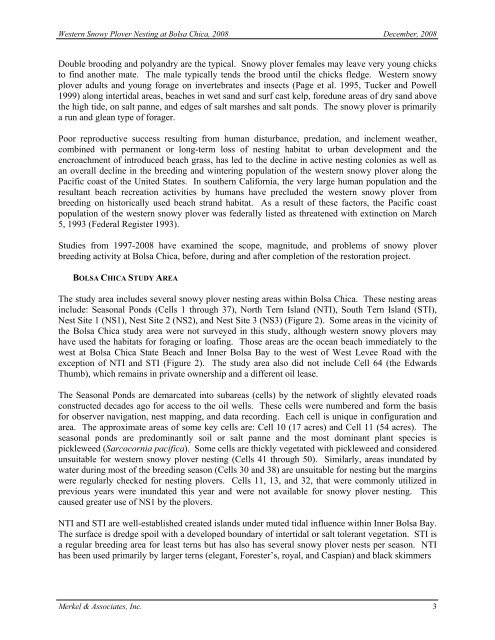2008 Annual Monitoring Report (pdf 10.9MB) - Bolsa Chica ...
2008 Annual Monitoring Report (pdf 10.9MB) - Bolsa Chica ...
2008 Annual Monitoring Report (pdf 10.9MB) - Bolsa Chica ...
Create successful ePaper yourself
Turn your PDF publications into a flip-book with our unique Google optimized e-Paper software.
Western Snowy Plover Nesting at <strong>Bolsa</strong> <strong>Chica</strong>, <strong>2008</strong> December, <strong>2008</strong><br />
Double brooding and polyandry are the typical. Snowy plover females may leave very young chicks<br />
to find another mate. The male typically tends the brood until the chicks fledge. Western snowy<br />
plover adults and young forage on invertebrates and insects (Page et al. 1995, Tucker and Powell<br />
1999) along intertidal areas, beaches in wet sand and surf cast kelp, foredune areas of dry sand above<br />
the high tide, on salt panne, and edges of salt marshes and salt ponds. The snowy plover is primarily<br />
a run and glean type of forager.<br />
Poor reproductive success resulting from human disturbance, predation, and inclement weather,<br />
combined with permanent or long-term loss of nesting habitat to urban development and the<br />
encroachment of introduced beach grass, has led to the decline in active nesting colonies as well as<br />
an overall decline in the breeding and wintering population of the western snowy plover along the<br />
Pacific coast of the United States. In southern California, the very large human population and the<br />
resultant beach recreation activities by humans have precluded the western snowy plover from<br />
breeding on historically used beach strand habitat. As a result of these factors, the Pacific coast<br />
population of the western snowy plover was federally listed as threatened with extinction on March<br />
5, 1993 (Federal Register 1993).<br />
Studies from 1997-<strong>2008</strong> have examined the scope, magnitude, and problems of snowy plover<br />
breeding activity at <strong>Bolsa</strong> <strong>Chica</strong>, before, during and after completion of the restoration project.<br />
BOLSA CHICA STUDY AREA<br />
The study area includes several snowy plover nesting areas within <strong>Bolsa</strong> <strong>Chica</strong>. These nesting areas<br />
include: Seasonal Ponds (Cells 1 through 37), North Tern Island (NTI), South Tern Island (STI),<br />
Nest Site 1 (NS1), Nest Site 2 (NS2), and Nest Site 3 (NS3) (Figure 2). Some areas in the vicinity of<br />
the <strong>Bolsa</strong> <strong>Chica</strong> study area were not surveyed in this study, although western snowy plovers may<br />
have used the habitats for foraging or loafing. Those areas are the ocean beach immediately to the<br />
west at <strong>Bolsa</strong> <strong>Chica</strong> State Beach and Inner <strong>Bolsa</strong> Bay to the west of West Levee Road with the<br />
exception of NTI and STI (Figure 2). The study area also did not include Cell 64 (the Edwards<br />
Thumb), which remains in private ownership and a different oil lease.<br />
The Seasonal Ponds are demarcated into subareas (cells) by the network of slightly elevated roads<br />
constructed decades ago for access to the oil wells. These cells were numbered and form the basis<br />
for observer navigation, nest mapping, and data recording. Each cell is unique in configuration and<br />
area. The approximate areas of some key cells are: Cell 10 (17 acres) and Cell 11 (54 acres). The<br />
seasonal ponds are predominantly soil or salt panne and the most dominant plant species is<br />
pickleweed (Sarcocornia pacifica). Some cells are thickly vegetated with pickleweed and considered<br />
unsuitable for western snowy plover nesting (Cells 41 through 50). Similarly, areas inundated by<br />
water during most of the breeding season (Cells 30 and 38) are unsuitable for nesting but the margins<br />
were regularly checked for nesting plovers. Cells 11, 13, and 32, that were commonly utilized in<br />
previous years were inundated this year and were not available for snowy plover nesting. This<br />
caused greater use of NS1 by the plovers.<br />
NTI and STI are well-established created islands under muted tidal influence within Inner <strong>Bolsa</strong> Bay.<br />
The surface is dredge spoil with a developed boundary of intertidal or salt tolerant vegetation. STI is<br />
a regular breeding area for least terns but has also has several snowy plover nests per season. NTI<br />
has been used primarily by larger terns (elegant, Forester’s, royal, and Caspian) and black skimmers<br />
Merkel & Associates, Inc. 3






